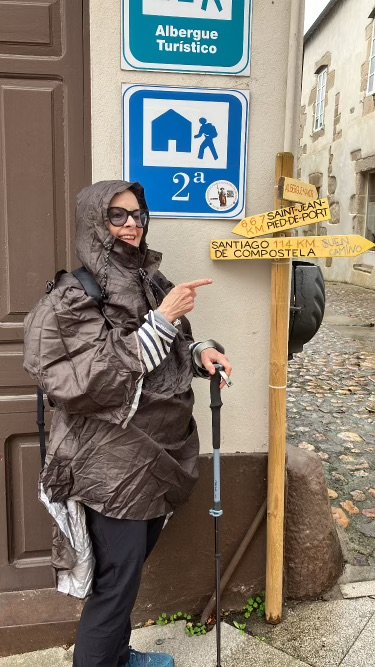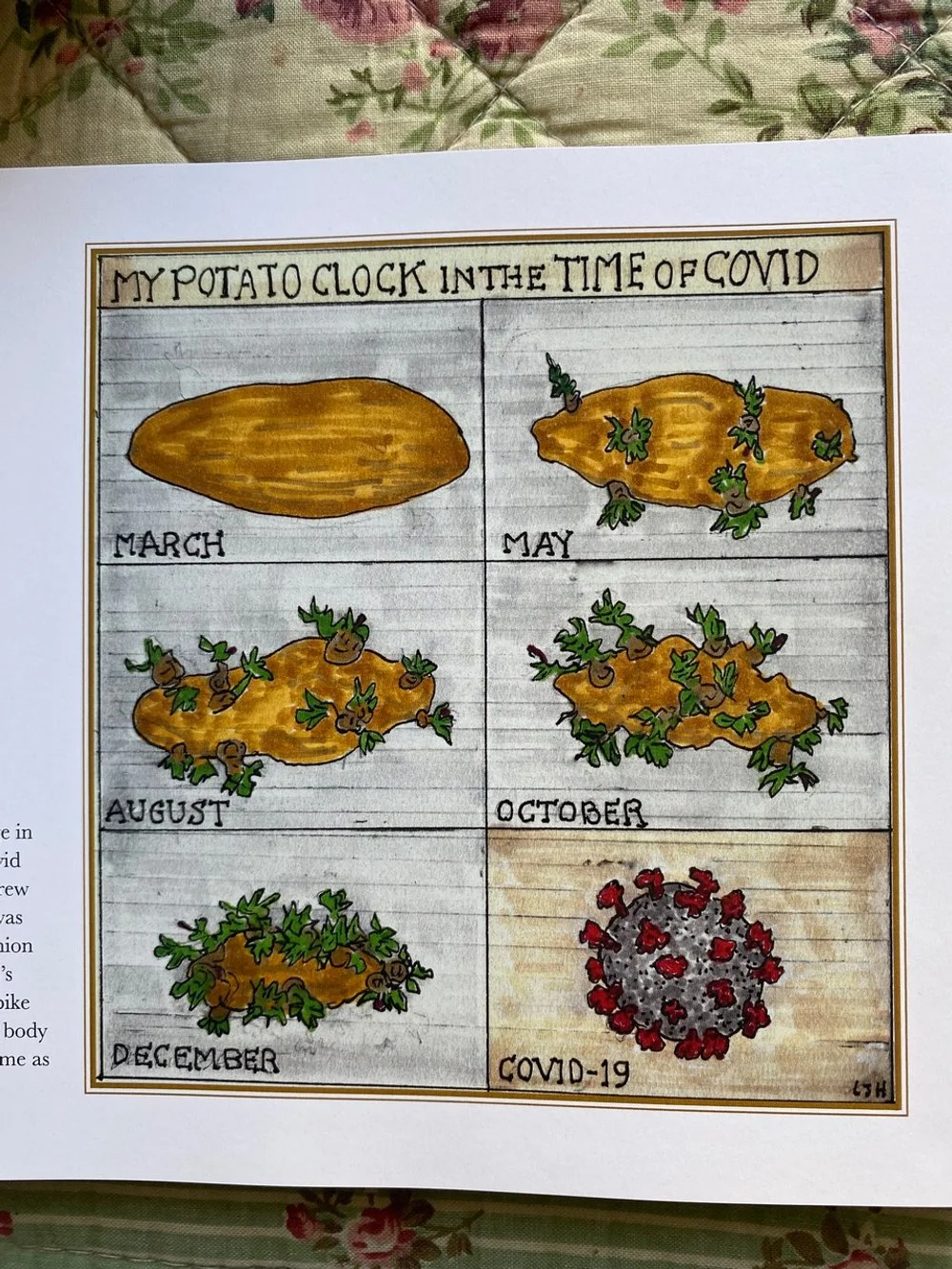when a clown becomes king, the palace becomes a circus
Book Review: My Little Plague Journal by L. John Harris
Bienvenue and welcome back to Musée Musings, your idiosyncratic guide to Paris and art. I am finally back in my cosy flat in Paris. During my absence, apartment seasons changed so the flat is not only cosy, but also warm. It seems incredible that walking the Camino de Santiago de Compostela followed by hanging out in Barcelona, lasted just a little over 2 weeks. That’s what I love about traveling. There is no coasting, there is no sleep walking through your days. Unlike being at home - even if home is Paris and your quotidian activities include walking a few blocks to get a baguette from a boulangerie that the New York Times celebrated this past July for its crusty baguettes - there is no routine when you are traveling. Every day is different. The only ‘given’ is that anything might happen. Every minute of your day is alive!
As I was preparing to walk the Camino, I consulted with two friends, Barb and Caroline, who had walked portions of the Camino in previous Octobers. Both reported warm to very warm weather. Barb reported one day of rain. So, as Ginevra and I began organizing our trip, it was with warm weather in mind. My chief worry was this: would I be able to convince Ginevra to start walking before the real heat of the day set in.
About six weeks before we were scheduled to depart, I plugged ‘Weather for Santiago de Compostela’ into the Weather App on my cell phone. And I began consulting it. At first every couple of days, eventually every couple of hours. The closer we got to our day of departure, the clearer it became that hot weather was not going to be an issue. At first, a few ’35% chance of rain’ days were predicted, but that fluctuated so much, (like Paris and San Francisco), I decided not to worry about it. That is, until the changes were only going in one direction, cooler and cooler weather, more and more days of 70%+ chance of rain. So, the day before we left Paris, we bought Ginevra a rain jacket. She refused to buy a poncho like the one I had. We considered and then rejected buying rain pants and rain protection for Ginevra’s backpack. We weren’t going to be walking that long, we didn’t want to drag around so much stuff if the chances of using all that stuff were so slim. We definitely did not follow the Boy Scouts’ motto, ‘Always Be Prepared.’ I’ll tell you more about our Camino next time. Especially the day we walked 24 km in heavy rain and gale force winds. And I learned that my poncho was not waterproof. (Fig 1)
Figure 1. Setting off for Santiago de Compostela
Today, though, in the homestretch to the craziness that happens every four years in the United States, I want to tell you about a book I recently reread by Berkeley based, L. John Harris, who I met here in Paris a few years ago. (Fig 2)
Figure 2. My Little Plague Journal, L. John Harris
‘My Little Plague Journal’ is a sometimes funny, sometimes poignant review of all the things that a sociable bachelor and foodie and draftsman, who has more than a passing interest in history and art history and literary history, did and saw and learned during the pandemic. Activities and pensées that kept him more or less intact but didn’t keep him from tracing the physical decline and fall of a man not accustomed to staring at himself so often and for so long in the mirror.
John begins by documenting, in words and images, a potato he put on his window ledge. (Fig 3) In the potato’s defense, it was a living thing that naturally decayed over time. That it eventually looked like Covid-19 was really not its fault. It reminded me of the package of Twinkies that Michale Pollan (whose famously said: “Eat food. Not too much. Mostly plants”) kept on a window ledge in his office. Which was as soft and fresh a year later as it had the day Pollan bought it. Make mine potato.
Figure 3. The potato and how it decayed, L. John Harris
John’s references to van Gogh’s Potato Eaters fit right in. (Fig 4) And his discussion of St. Sebastian as the plague saint whose arrows “represent divine anger thrown down upon mankind for its sins,” made me wonder why I had never wondered what those arrows that pierced Sebastian’s body but didn’t kill him, meant. (Fig 5)
Figure 4. Potato Eaters, Vincent Van Gogh
Figure 5. Martyrdom of St. Sebastian, Andrea Mantegna
References to the medieval plague doctor of the Commedia dell’arte (Fig 6) took me back to Venice and the beaked masks on sale in all the mask shops. Now I understand that those beaks were worn by doctors trying to protect themselves from the toxic vapors of their patients. Adrian Proust, Marcel’s father survived cholera outbreaks (and devised pandemic protocols) by protecting himself that way, too.
Figure 6. Plague Doctor and Mask to protect him from the plague
John’s foodie self suffered the most during the pandemic. And his efforts to keep in touch with friends through Decameron like Zoom meetings and tailgate meals with friends at acceptable distances were both eerie and heartbreaking.
As I read John’s book, I thought back to how artists like David Hockney and Damien Hirst responded to the pandemic. For those artists, the pandemic, with all of its restrictions, offered a gift of time. When all the commitments that typically filled their lives and kept them away from their work, disappeared. Hockney moved to Normandie and found new subjects and devised new ways of seeing (Fig 7). Hirst created paintings of cherry tree blossoms on canvases, overwhelming in their scale, comforting in their beauty. (Fig 8) As Hockney said, ‘Do remember, they can’t cancel the spring.’
Figure 7. Normandie, David Hockney
Figure 8. Spring Cherry Blossoms, Damien Hirst
Hockney and Hirst are English, but reviews of their work and their own personal reflections, never mention Boris Johnson, the clown of chaos (Fig. 9) who was Britain’s Prime Minister during Covid. I recently read a 2023 report by the British commission that analyzed England’s pandemic response. The panel confirmed (according to Reuters) that, “Former British Prime Minister Boris Johnson's approach to dealing with the COVID-19 pandemic was "mad and dangerous" and his constant indecision made it "impossible" to tackle the virus. The panel's most senior official…described Britain's response in 2020 as a "terrible, tragic joke,” and compared Johnson's approach to those of…Donald Trump and Brazilian President Bolsonaro, who were known for dismissing the threat of COVID…”
Figure 9. Elect A Clown Expect A Circus, poster
Johnson was forced to resign as Prime Minister and Bolsonaro was voted out of office. Neither of them has any chance of getting their old jobs back. But the American clown whose antics and inaction may have led to the deaths of many thousands of people, is trying to get his old job back (which he never accepted as having lost).
John’s book has a large section devoted (not quite the right word) to Trump. Which makes his plague journal not just a record of incompetence past but a warning about potential incompetence future. Before I share some highlights from John’s Trump musings and my own thoughts about Trump, I want to mention that every French person I have spoken to lately, from the cabbie who drove us home from the airport on Monday to the young women at Palais du Thé, where we bought our tea yesterday, has told me that they wished they had the right to vote in the United States. Because if they did, they would get on a plane and go to the United States to vote for Kamala Harris. I didn’t mention that I had already voted by mail because voting by mail is not a thing in France. Nor, for that matter, are year long election campaigns during which obscene amounts of money are spent. The closest the French get to voting by mail is voting by proxy, that is, giving someone permission to vote for you if you cannot get to your voting place on the day of a vote.
As you know, I’m from San Francisco, so what John writes resonates for me. It might not for you. If it doesn’t, stop here.
Here is how John begins his discussion about what he calls America’s ‘interwoven viruses - Trump and Covid.’ “Reading up on plagues past, I have yet to find anything in the history of the mother of all plagues- Europe’s Black Death- that offers a merger of contagion and ruler comparable to Pharaoh and the biblical plagues or, fast forward, Donal Trump and Covid-19.” According to John, “The drama of Oedipus Rex seems the closest comparison of all the great plague/ruler narratives - historical or literary - to that of Trump Rex. Except that Oedipus was a tragic hero who accepted responsibility, whereas Trump of course never has.” (Figure 10)
Figure 10. Oedipus vs Trump, L. John Harris
“Viral plagues,” John reminds us, are “much more insidious than bacterial ones. You can kill a bacterium more easily than a virus.” It was a 2020 New Yorker article (David Joselit, June 5, 2020) that helped John “understand our merged Covid /Trump catastrophe not so much in cultural and political terms but biologically.” Joselit explains that Trump “legitimized a relation to knowledge that is viral rather than evidence based.” To John, “our election was about a once healthy body politic under attack by a parasitic organism called Trump.” In 2021, John created a political campaign poster, “this one on hold for, God forbid, 2024” (Fig 11) Which is exactly where we happen to find ourselves right now. Nearing the end of a race that has been declared too close to call.
Figure 11. Trump for President (anti) Poster, 2024 (created in 2021) L. John Harris
I keep waiting for someone like Joseph Welch, the man who finally silenced Joseph McCarthy, to appear. That was 1954, 70 years ago, during televised hearings. Army Counsel Joseph Welch challenged the senator's reckless charges by asking, “Have you no sense of decency, sir?” But the mid-1950s was a simpler time, a time when people accepted the concept of ‘facts’ before the current clowns convinced a gullible populace that facts do not exist and that anything they don’t agree with is ‘fake news.’ McCarthy’s reign of terror ended. His support eroded. The Senate censured him for conduct unbecoming a senator. Lynn Cheney, daughter of George Bush’s despicable Vice President, sacrificed her political career to speak the truth. She has only been vilified by Trump and his cronies. If Trump is re-elected he promises to jail all of his adversaries. Maybe Liz Cheney will share a cell with Kamala Harris. And Tim Walz might have Gavin Newsom (Governor of California, former Mayor of San Francisco) as a cell mate. If the unspeakable happens and Trump wins, will the great American experiment end immediately or gradually? Will our rights be taken all at once or will they erode bit by bit? How did we get here?
Gros bisous, Dr. B.











